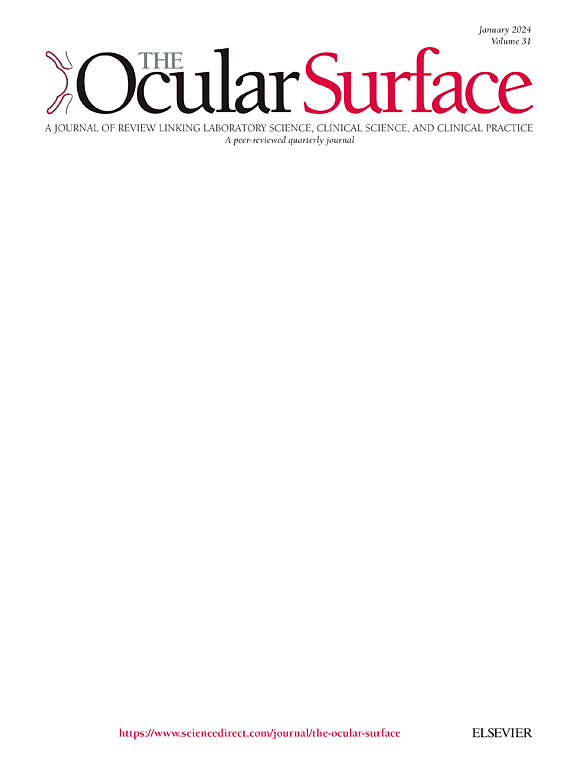大气泡 DALK:进化中的一种技术。
IF 5.9
1区 医学
Q1 OPHTHALMOLOGY
引用次数: 0
摘要
深前片状角膜移植术(DALK)被认为是穿透性角膜移植术(PK)的一种重要替代方法,可用于治疗不涉及内皮的角膜疾病。DALK 保留了宿主内皮,消除了内皮排斥的风险,并降低了因内皮衰变而导致后期移植物失败的风险。尽管 DALK 术问世时间不长,但一直被认为是一种难度大、时间长、可重复性差的手术,这限制了它在全球范围内的应用。随着大气泡技术(BBT)的引入,可重复性和完成手术所需的时间都得到了显著改善,鼓励了许多外科医生采用 DALK。大气泡技术将空气注入角膜基质层,诱导角膜层间分离,促进病变或瘢痕角膜基质层与健康角膜内皮层的分离;这样就能创造出具有原始光学质量的移植物-宿主界面,获得与 PK 技术相同的临床效果。前戴斯麦层(Dua层)的发现对了解大泡形成背后的原理起到了重要作用,极大地影响了该技术的安全性和可重复性。BBT的形成受术前病理、切削大小和注入空气所用器械的影响。不断的进步帮助完善了BBT的疗效和可重复性,扩大了其在角膜移植中的适用范围,只要角膜内皮是健康的。本综述详细介绍了使用BBT进行DALK的手术步骤,解决了最常见的难题,突出了技术创新,并处理了最常见的并发症。本文章由计算机程序翻译,如有差异,请以英文原文为准。
Big-bubble DALK: A technique in evolution
Deep anterior lamellar keratoplasty (DALK) is considered a valuablealternative to penetrating keratoplasty (PK) for treatingcorneal disordersthat do not involve theendothelium. DALK preserves the host endothelium, eliminating the risk of endothelial rejection and reducing the risk of late graft failure due to endothelial decay. Despite its not recent introduction, DALK has been considered a difficult, lengthy, and poorly reproducible procedure, limiting its adoption worldwide. With the introduction of the big-bubble technique (BBT) the reproducibility and the time required to complete the procedure were significantly improved, encouraging many surgeons to approach DALK. With BBT air is injected into the stroma to induce separation between the layers of the cornea, facilitating the separation of the diseased or scarred stroma from the healthy endothelium; this allows the creation of a graft-host interface of pristine optical quality, granting clinical results equal to those obtained with PK.Understanding the anatomy and physics behind the big bubble (BB) formation is crucial for thesurgical success of this technique. The discovery of the pre-Descemet's layer (Dua's layer)played a significant role in understanding the principles behindBBformation, considerablyimpacting the safety and reproducibility of the technique. BB formation is influenced by preoperative pathology, trephination size, and instruments used for air injection.Continue advancements have helped to refine BBT's efficacy and reproducibility, broadening its applicability in corneal transplantation whenever the endothelium is healthy.This review provides a detailed account of the procedural steps involved in DALK using the BBT, addressing the most common challenges, highlightingtechnical innovations, and handlingthe most frequent complications.
求助全文
通过发布文献求助,成功后即可免费获取论文全文。
去求助
来源期刊

Ocular Surface
医学-眼科学
CiteScore
11.60
自引率
14.10%
发文量
97
审稿时长
39 days
期刊介绍:
The Ocular Surface, a quarterly, a peer-reviewed journal, is an authoritative resource that integrates and interprets major findings in diverse fields related to the ocular surface, including ophthalmology, optometry, genetics, molecular biology, pharmacology, immunology, infectious disease, and epidemiology. Its critical review articles cover the most current knowledge on medical and surgical management of ocular surface pathology, new understandings of ocular surface physiology, the meaning of recent discoveries on how the ocular surface responds to injury and disease, and updates on drug and device development. The journal also publishes select original research reports and articles describing cutting-edge techniques and technology in the field.
Benefits to authors
We also provide many author benefits, such as free PDFs, a liberal copyright policy, special discounts on Elsevier publications and much more. Please click here for more information on our author services.
Please see our Guide for Authors for information on article submission. If you require any further information or help, please visit our Support Center
 求助内容:
求助内容: 应助结果提醒方式:
应助结果提醒方式:


